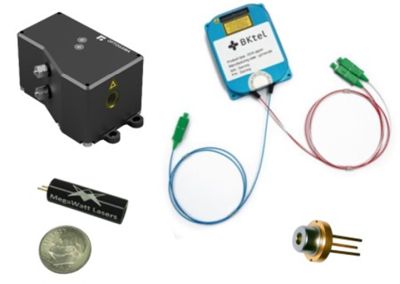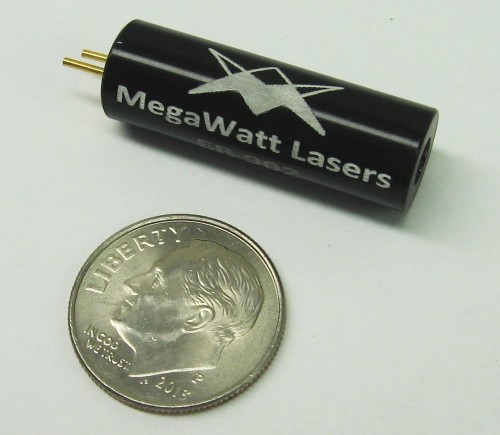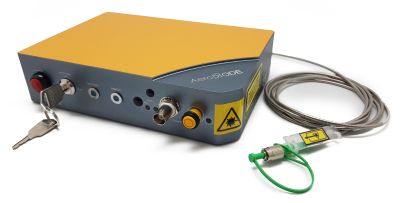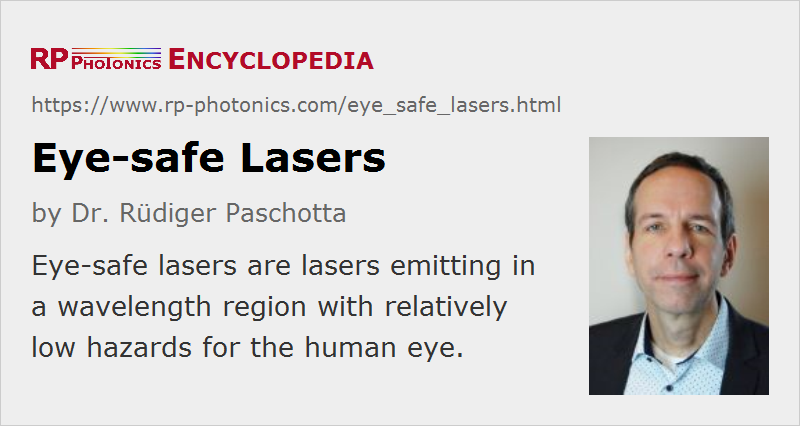Eye-safe Lasers
Definition: lasers emitting in a wavelength region with relatively low hazards for the human eye
More general term: lasers
German: augensichere Laser
Category:  laser devices and laser physics
laser devices and laser physics
Author: Dr. Rüdiger Paschotta
Cite the article using its DOI: https://doi.org/10.61835/pie
Get citation code: Endnote (RIS) BibTex plain textHTML
Lasers with emission wavelengths longer than ≈ 1.4 μm are often called "eye-safe because light in that wavelength range is strongly absorbed in the eye's cornea and lens and therefore cannot reach the significantly more sensitive retina. This makes e.g. erbium lasers and erbium-doped fiber amplifiers used in 1.5-μm telecom systems or 2-μm thulium lasers far less dangerous than e.g. 1-μm lasers with similar output powers. Another class of eye-safe laser sources are optical parametric oscillators.
On the other hand, the absorption length of the cornea reaches tiny values (well below 0.1 mm) at longer wavelengths, particularly around 3 μm and around 10 μm (near the wavelength of CO2 lasers). This means that light pulses at such wavelengths are absorbed in a very thin layer so that the cornea can easily be damaged. Therefore, lasers emitting around 3 μm or 10 μm are less eye-safe than e.g. lasers emitting around 1.5 μm, even though they are “retina-safe”. While the outer surface of the cornea (the epithelium) can at least heal within a couple of days after damage, this is not the case for the inner part (the endothelium). Also, corneal injuries can be very painful.
Obviously, the quality “eye-safe” depends not only on the emission wavelength, but also on the optical power (or energy) level and the optical intensity which can reach the eye. With sufficiently high power, such as is reached with a fiber amplifier or with a Q-switched laser, the eye can still be damaged. However, it can already be very helpful if at least weak parasitic reflections of some main beam are not dangerous for the eyes. Thus, such lasers may at least be relatively eye-safe – comparing with other lasers having the same output power but in some more critical wavelength region.
Note that the laser power alone (or the intensity at the laser output) is not sufficient to assess the possible intensity in the eye; that also depends on other factors, such as the beam divergence and beam quality. Therefore, one cannot simply state a power or intensity limit for eye safety at a given wavelength.
Types of Eye-safe Lasers
Here are some examples for typical types of eye-safe lasers:
- Erbium lasers emitting in the 1.5-μm spectral region can be realized either as bulk lasers or as fiber lasers. With bulk lasers, e.g. based on an Er:glass piece, one generate pulses with higher pulse energy for long-distance range-finding and other LIDAR applications, for example.
- Thulium lasers often emit at wavelengths somewhat below 2 μm and can also be either bulk lasers or fiber lasers.
- Many semiconductor lasers also emit in eye-safe spectral regions.
Applications of Eye-safe Lasers
Eye-safe lasers are particularly important in application cases where light needs to be transmitted over substantial distances in open air. Typical examples are laser rangefinders, e.g. in the context of autonomously driving cars (see also the article on LIDAR), wind sensors for wind turbines and free-space optical communications.
Even in optical fiber communications, eye-safe wavelengths are beneficial, as a fiber cable may be broken such that light can exit the fiber.
There are also eye-safe lasers in military applications, for medical procedures and in various other fields.
More to Learn
Encyclopedia articles:
Suppliers
The RP Photonics Buyer's Guide contains 34 suppliers for eye-safe lasers. Among them:


Optogama
Optogama offers various types of lasers: eye-safe 1,54 μm diode-pumped passively Q-switched and CW erbium glass lasers as well as passively Q-switched Nd:YAG lasers.
Eye-safe 1,54 μm wavelength nanosecond lasers of the “KAUKAS“ (1, 2, 3) series have a unique compact design and are available in OEM models for dedicated applications. These lasers delivers up to 3 mJ energy per pulse with pulse duration <10–15 ns, TEM00 beam profile and repetition rate of up to 5 Hz.
„KAUKAS HR“ laser models have an adjustable repetition rate and deliver more than 30 µJ energy per pulse with a repetition rate of up to 1 kHz available on request.
“KAUKAS CW” diode-pumped, solid-state laser models deliver up to 400 mW of continuous-wave power at 6 wavelength in the 1,5–1.6 μm spectral range.


RPMC Lasers
RPMC Lasers offers a large selection of "eye-safe" or "retina-safe" lasers above ≈1.4 µm in the SWIR, MWIR, and LWIR wavelength ranges. These "eye-safe" offerings include both CW and pulsed diode lasers, superluminescent laser diodes (SLEDs), quantum cascade laser diodes (QCLs), DPSS lasers, and fiber lasers. Our pulsed lasers are available with either active or passive Q-switching, and our continuous-wave (CW) lasers are available in both single- and multi-longitudinal mode options. Let RPMC help you find the right laser today!


Megawatt Lasers
MegaWatt Lasers's ER902 is a passively Q-switched erbium glass laser that operates at 1.54 μm. This eye-safe wavelength is ideal for defense, LIBS, and LIDAR applications. The design allows for 10 Hz repetition rates with a 4 ns pulse width and a 200 μJ pulse energy. All in a 9 mm diameter by 20 mm length package.


AeroDIODE
SHIPS TODAY: AeroDIODE offers several fiber-coupled laser diodes modules in the eye-safe wavelength range like 1480 nm or 1550 nm diodes. Most eye-safe laser diode are offered as stock items or associated with a CW or pulsed laser diode driver. They are compatible with our high speed nanosecond pulsed drivers or high power CW drivers (with air cooling) for the multimode high power laser diode versions. The single mode laser diodes (either Fabry–Pérot or DFB laser diode) can reach high power in nanosecond pulse regime up to 400 mW. Most turn-key diode & driver solutions are optimized for single-shot to CW performances with pulse width lengths down to 1 ns. The laser diode precision pulses are generated internally by an on-board pulse generator, or on demand from an external TTL signal. Many multimode versions are available with CW emission up to 450 W in a 200-µm core multimode fiber or up to 250 W in a 135-µm core fiber or 160 W in a 105 µm core fiber.
See also our tutorial on fiber-coupled laser diodes.


Lumibird
Lumibird manufactures a large range of eye-safe lasers in the range of 1.5 µm, through different technologies. We obtain these wavelengths with DPPS OPOs, erbium-doped fiber lasers and diode lasers.
Questions and Comments from Users
2022-08-05
How can infrared lasers as used by optometrists for optical coherence tomography be classified as perfectly eye-safe?
The author's answer:
They can be perfectly safe provided that the resulting optical intensity on the retina is small enough and/or the exposure time is sufficiently limited. Laser light is not necessarily dangerous if it is in the infrared.
2023-07-25
Manufacturers often advertise their lasers at 1550 nm as “eye-safe” independently of the maximum power. It is hard to find numbers to rely on to know what is the limit for a laser to remain eye-safe at this wavelength. Do you have an order of magnitude in term of maximum power that would still be considered eye-safe, or a number that relates to what is considered dangerous for the human eye?
The author's answer:
The risk for the eye depends on various factors, including e.g. spatial properties of the beam. See the article on laser safety for more details.
Here you can submit questions and comments. As far as they get accepted by the author, they will appear above this paragraph together with the author’s answer. The author will decide on acceptance based on certain criteria. Essentially, the issue must be of sufficiently broad interest.
Please do not enter personal data here; we would otherwise delete it soon. (See also our privacy declaration.) If you wish to receive personal feedback or consultancy from the author, please contact him, e.g. via e-mail.
By submitting the information, you give your consent to the potential publication of your inputs on our website according to our rules. (If you later retract your consent, we will delete those inputs.) As your inputs are first reviewed by the author, they may be published with some delay.






2021-09-21
How about the safety of quantum cascade lasers used in microscopes?
The author's answer:
Quantum cascade lasers are operating in the long-wavelength region where the radiation is absorbed already in the cornea. It could be harmful if it were intense enough to substantially heat the cornea. That should usually not be the case in the mentioned application.